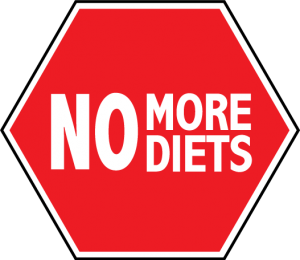January is the month for making lifestyle changes: quit smoking, spend less, make time for loved ones, exercise more, or eat less. If weight loss is a resolution of yours, it is easy to fall into the trap of wanting to restrict calories to make up for all the poor food choices made the prior month. Many of us fall victim to the idea that eating less and moving more is the key to weight loss success. In fact, how could you not, with the billions of advertising dollars spent on pushing diet plans, exercise programs, and fat loss supplements that contain the predominant message to exercise more and restrict calories. It’s very easy to be misled.
The problem comes when we restrict calories too much. There is a fine line between reducing caloric intake and seeing steady fat loss progress (300-500 calories), and restricting too much (anything more) to the point where we negatively impact the functions of the body that can lead to reduced metabolism, increased fat storage, and increased food cravings. In my many years of coaching clients on nutrition, I can’t tell you how many times I have seen people severely under feed themselves, train hard, and yet find themselves plateauing or gaining fat. It’s frustrating, and all too common.
When you deprive your body of adequate calories, your body will respond by conserving energy and instead direct calories to necessary functions for survival, your body burns even fewer calories even though you are training hard and eating less. This in turn leads to stored body fat overtime.
When you do not eat enough your body reduces the active thyroid hormone, shuts down sex hormone production and elevates the adrenal stress hormones cortisol. Chronic elevated cortisol levels lead to insulin resistance; this promotes body fat retention and can cause long term health problems beyond stagnant weight loss.
When calories are scarce the body will prioritize essential functions like respiration and regulating body temperature over rebuilding muscle tissue. Even though you have the best intentions of strength training to aid in fat loss your body will not rebuild muscle tissue. So muscle mass decreases, and in turn resting metabolism also decreases. As muscles tissue demands calories to survive, fat tissue requires very little. In fact, muscle tissue burns 5x more calories than fat tissue. Even scarier is if you are under-feed for your workouts your body will actually pull protein from the muscles to fuel the workout. That means no rebuilding, and muscle tissue breakdown. Not a good state of affairs to be in.
Finally, under-eating can also affect sleep quality. Sleep quality is essential to recovery between workouts and shedding body fat. Poor sleep is linked to elevated cortisol levels, and as previously mentioned can lead to fat storage.
How do you know if you are not eating enough? There are some common symptoms of under-eating:
Low energy
Poor sleep
Brain fog
Sugar Cravings
Low sex drive
Infertility
Constipation
Poor performance in the gym
Slow recovery between workouts
If you are suffering from some of the above symptoms and have struggled with losing weight then it is very likely that you are not eating enough. Luckily, once you start eating the right amount of calories these symptoms should clear up.
So how much calories should you be eating? I am going to previse this by saying everyone is unique in what they need given their goals, activity level, age, and body type. Therefore, it is difficult to give one answer. That being said, I can give you a general guideline for determining what may be an acceptable starting point for determining your calorie needs. If you are looking to lose weight and lead a sedentary lifestyle then you could use the formula of taking your ideal body weight and multiplying by 10. This would be the minimum caloric intake you should be consuming. For women start with 100 lbs. for 5’0” for men start at 110 lbs. and add 5 lbs for each inch in height. A woman who is 5’ 5” has an “ideal” body weight of around 125 pounds, so she should not eat less than 1250 calories per day. Now if you are active you would need to determine how many calories you burn through your physical activities. You can find a general list of estimated calories burned per hour for activities here. You would then need to include the calories burned to determine the minimum calories needed.
Tracking your calories is a great short-term solution to under-eating, but don’t freak out if your calorie intake fluctuates around your goal number from day to day, or if you don’t track every single day. And remember, this number will change as time goes on and your life circumstances and goals change.
If you discover that you need to significantly up your caloric intake, try adding 100-200 calorie increments every other week in order to minimize weight gain during the refeeding process. Calorie adjustments usually take some experimentation, but correcting under-eating almost always results in significant improvements in health, energy, and performance. And once you’re feeling better, you can use a more intuitive eating style to continue making progress. You’ll be amazed at all the improvements that come from a simple increase in caloric intake if you have been chronically under-eating!
If you want a more accurate assessment on calories required and exact macro-nutrient break down for your specific goals and lifestyle feel free to email me andrea@achievetruebalance.com to schedule an in person nutrition consultation to get you on the road to successful weight loss in 2016.



Leave a Reply